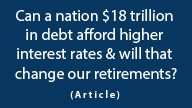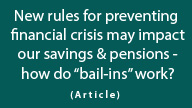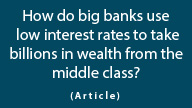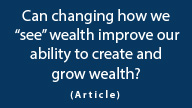How Financial Reality Is Hidden By Commonly Used Theory & Jargon
by Daniel R. Amerman, CFA
(The video above is a shorter version of the much more in-depth article below.)
As we will explore in this analysis, when we look at two of the largest sources of net worth in the United States – housing and stocks – then what history shows us is that for 22 out of the 40 years between 1972 and 2012, much of the truth about financial performance has been almost invisible to people who have been relying on the most commonly used definitions for inflation and deflation.
That is, most people phrase the question as being one of either a) inflation, or b) deflation, meaning it has to be one or the other and obviously can't be both together. As we will explore using simple to follow, round number examples, taking this seemingly common sense approach leaves us unable to distinguish between a 20% gain, a 20% loss and a 94% loss.
We will then apply the type of methodology used by some of the most sophisticated investors in the world, which splits changes in the value of assets from changes in the value of money. When we take this step, then the possible answers are no longer limited to either A) inflation or B) deflation, but expand to also include C), both inflation and deflation occurring at the same time.
As we will discover, for the largest sources of household net worth during the 22 years analyzed out of a 40 year period – the answer was indeed c) both inflation and deflation, at the same time. Thus, the past didn't work the way most people think it did.
And there are compelling reasons to think that this third possibility of simultaneous inflation and deflation may also define the path ahead of us. If so, those who rely on the most common definitions for inflation or deflation may be unnecessarily placing themselves at risk, simply because they don't fully anticipate the third possibility, which historically speaking, also happens to be the most common outcome for stressed economic conditions.
Theoretical Economics Perspective
Let's start with Economics 101, where the definitions of inflation and deflation are fairly straightforward.
Inflation is an increase in the money supply.
Deflation is a decrease in the money supply.
It would seem fairly straightforward, then, that we can't have both inflation and deflation at the same time, so therefore it must be one or the other.
Unfortunately, that's where the straightforward part ends. Just what does “money supply” mean anyway? Is it M1? Is it M2? Is it M3? What about credit? What about the value of real estate and other assets? (And for the average person – what do those "Ms" mean anyway?)
Once you have (somehow) picked a definition for “money supply”, what are the practical implications for you and your savings? Unfortunately, that's another problem with these theoretically correct definitions of inflation and deflation. Any linkage between that commonly accepted definition of inflation and actual price levels is, well, highly theoretical. Some economists write papers saying one thing, then others write papers disagreeing with them – it’s the perfect subject for endless debates, because it’s unsolvable.
An even more dangerous problem can be found when we look at the typical "inflation versus deflation" debate, as if those were the only two choices. For instance, if we look at an asset like a house or a share of stock, then an increase in price means inflation, and a decrease in price means deflation. Again – by the common definition – we can't have both inflation and deflation at the same time; therefore it obviously must be one or the other.
Finance & Applied Wealth Management Perspective
Now let's move from theoretical economics to investment decisions in the real world. One of the core principles that permeates professional finance is that a dollar isn't a dollar, not at different points in time.
To make real-world investment decisions, we use rates to compare dollars at those different points in time.
We usually incorporate inflation into our discount or compounding rates – at least implicitly.
The most common number that we use to represent inflation is the change in price levels, such as changes in the price of groceries. To capture a broad spectrum of price level changes, the consumer price index (CPI) is often used.
So from a Finance perspective – the perspective of applied wealth management for the most sophisticated investors in the world – I think it's fair to say that the norm is using price inflation rather than some theoretical money supply change that's too ambiguous to ever pin down. What’s the difference for you between these two definitions? And why should you care?
The Price Of Blindness
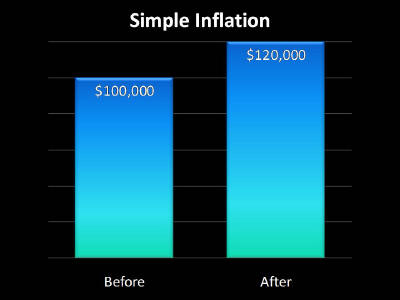
We’ll start with the Econ 101 perspective. The money supply, however we define that, went up. More money sloshing around the economy means prices rise. Our asset was worth $100, now it’s worth $120, so if we restrict our choices to only inflation or deflation, then by definition that’s inflation. And that’s pretty much all we know.

Now, let’s come in from a practical finance perspective. We started with a $100,000 asset, and we end up with a $120,000 asset. This asset could be a house, stocks, comic books, whatever you want it to be.
In this example, the dollar doesn’t change in value.
Since a dollar started out being worth a dollar, and ended up being worth a dollar, we end up with an asset worth $120,000.
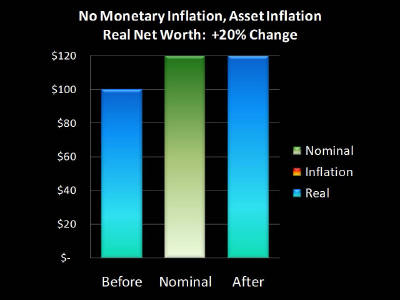
That means our net worth went up 20%, as shown on this graph. That’s great!
However, what if we define inflation not in terms of money supply, but well, changes in what a dollar will buy for us? After all, isn’t that the part of inflation that most people care about? What it costs to, well, buy things?
Changing The Value Of A Dollar
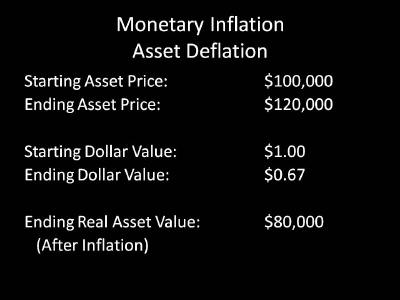
OK, we have exactly the same situation, from an Econ 101 perspective. We start with an asset price of $100,000, and end with an asset price of $120,000. Indistinguishable from our previous example.
Only this time we have inflation in the sense that most people mean it. A dollar becomes worth only 67 cents, in purchasing power terms. So, if we can sell our asset for $120,000, but each of those dollars in the future will only buy what 67 cents will today, what’s the real value of our asset? It has actually dropped to $80,000.

So when we look at our graph, the left bar shows our starting asset of $100,000, and if we consider only the ending number of dollars, then the middle bar of $120,000 would seem to indicate that there was a $20,000 profit. But when we account for each of our dollars only being worth 67 cents in purchasing power terms, the real value of our asset is only $80,000. The difference between the $80,000 and $120,000 is the fire of inflation.
When it comes to the purchasing power of the asset – which is what really matters – our asset experienced 20% asset deflation. Our loss was hidden by the dollar experiencing inflation, and losing a third of its purchasing power. In other words, the loss in the value of our money actually hid the loss in the value of our asset. But this combination of simultaneous inflation and deflation can only be seen if we split the valuation of money from the valuation of assets.
So when we use the most common way in which people look at inflation and deflation, which is to say it has to be either one or the other and can't be both simultaneously, then we’re unable to tell the difference between a 20% gain and a 20% loss. Interesting, and also a bit troubling.
And this becomes even more troubling if a dollar were to become worth a lot less than 67 cents over say, the next 10-20 years. Many people are quite understandably worried about a much higher and more dangerous degree of inflation due to the combination of the extraordinary level of federal budget deficits, the Federal Reserve creating trillions of dollars out of thin air, and the skyrocketing cost of paying for Social Security and Medicare as the Baby Boom generation retires.
High Rates Of Simultaneous Inflation & Deflation

OK, exact same situation, from an Econ 101 perspective. Starting asset price of $100,000, ending asset price of $120,000.
Only this time, a dollar ends up being worth only five cents.
If we can sell our asset for $120,000, but each dollar is only worth five cents, what happens to the real value of our asset, i.e. what it will buy for us? It plummeted all the way down to $6,000.
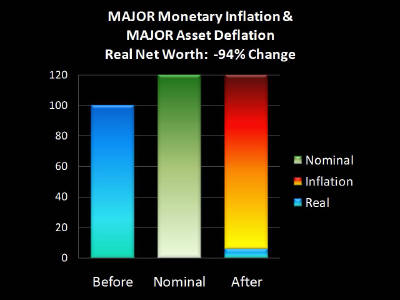
Our left and middle bars are just the same, but look at our right bar now. That $120,000 is almost all inflation, because we lost 94% of our net worth. We lost 94% of the value of our asset, which is massive asset deflation in purchasing power terms, but it was entirely hidden by the even larger 95% destruction of the value of the dollar.
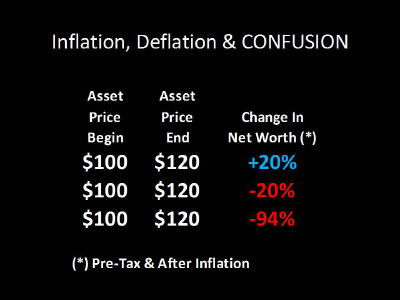
Three scenarios. In every case, we start with the same price, and we end with the same price, yet we have three radically different outcomes in our net worth. Now, if you take what some people consider to be the smart route of using the theoretical economics definition of changes in money supply – those outcomes will be impossible to tell apart. Or, if we restrict ourselves to assuming it has to be either inflation or deflation - then it is inflation in each case, and we also can't tell the difference.
However, if we use a methodology created specifically for practical, real world investment decisions – then these differences become boldly obvious.
So does this mean that only finance people have a clear vision for what's happening, and that all those economists have no idea? Of course not, that would be absurd.
Because here's the other thing you’ve got to keep in mind about our Econ 101 definition of inflation as being changes in the money supply. Economists don't use it either – not once something concrete and tangible needs to be done, such as calculating the growth of the national economy, or changes in productivity. For these types of practical calculations, ambiguous theory doesn't hack it, and thus economists also use changes in price levels, much like the finance people.
Unfortunately, many millions of people are paying a very real penalty for this clash of theory and jargon.
Real World Theory & Jargon Price 1: Blindness
The first price is that if you or your advisor can’t see the difference between gaining 20% and losing 94% because of the definition you choose – then you are investing blind. If you can’t even see what is happening, then your only hope for success is pure luck.
Real World Theory & Jargon Price 2: Confusion
The second price is confusion, and this one is affecting many millions of people right now. Given the issues with the economy and economic growth in the US and throughout the world, many thoughtful people are interpreting this to mean that the future is one of deflation. And because they assume it must be either inflation or deflation, then implicitly, the economic troubles that may create a long term environment of asset deflation, somehow therefore protect the value of money, so investors no longer have to worry about inflation.
This definition-based and overly-simplistic belief is dead wrong and profoundly dangerous for investors. When a nation gets into economic trouble, and it has a symbolic currency like the current US dollar, then simultaneous monetary inflation and asset deflation are the norm, and we have multiple examples of this in the United States in recent decades.
Let's start by taking a look at the stock market in recent years.
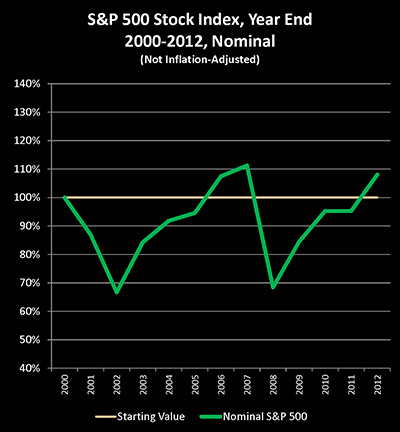
The Standard & Poor's 500 stock index bounced around quite a bit between the end of the year 2000 and the end of 2012, but the end result was an 8% gain over those 12 years. So if we restrict ourselves to saying it has to be either inflation or deflation, we have 8% asset inflation.
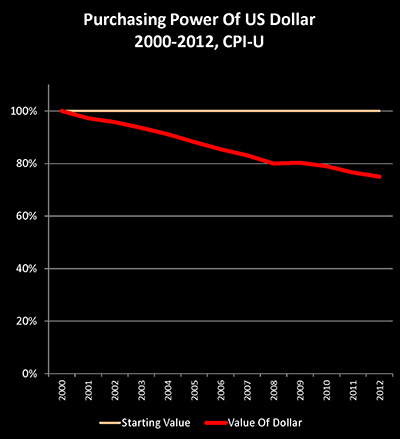
Until, that is, we adjust for the changing purchasing power of the US dollar. And if we take the Consumer Price Index as calculated by the US government, then a dollar by the year 2012 only had a purchasing power of 75 cents when compared to a dollar in the year 2000.
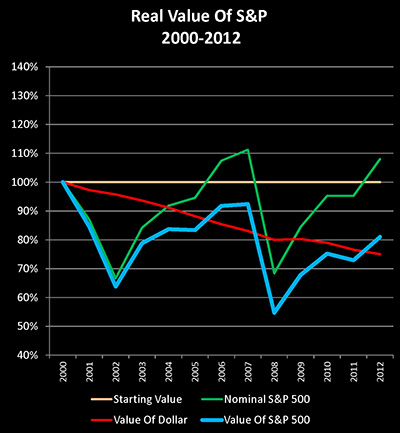
So when we look at historical prices for the S&P 500 (the green line), and we adjust for the falling value of the US dollar (the red line), we get a quite different picture for what happened to the purchasing power of the S&P 500 – and to US stocks in general – between the end of the year 2000 and 2012. In real terms, which is to say in purchasing power or inflation-adjusted terms, the stock market fell by 19% over this 12 year period (the blue line).
When we look at what assets will buy for us, then we experienced asset deflation of 19%. This asset deflation, or loss in value of the assets, was entirely hidden by the 25% destruction of the purchasing power of the dollar, i.e. inflation. And in the real world, we saw a combination of asset deflation and price inflation that could not be seen using theoretical definitions of the money supply, nor could it be seen if we had restricted ourselves to having either inflation or deflation, as is commonly done.
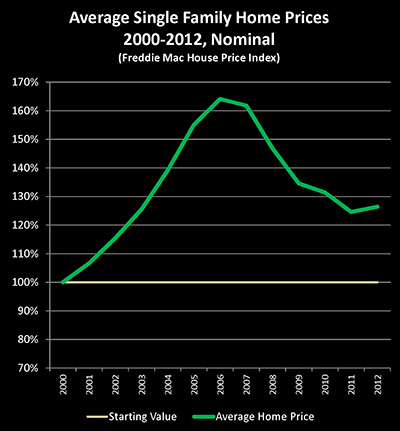
Now, let's take a look at what happened in the real estate market in the United States between the end of the year 2000 and the end of 2012. Between the end of the year 2000 and the end of 2006, the average single-family home in the United States rose by 64%, according to the Freddie Mac House Price Index (the green line). And as we all know, there was a sharp plunge in values with the collapse of the real estate bubble. However, as we can easily see, the plunge isn't as bad as it looks because the average house is still worth 26% more by the end of 2012 than it was in 2000.
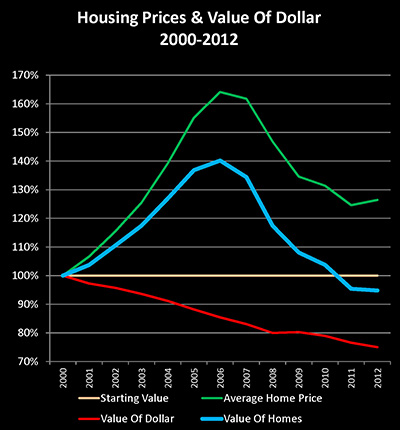
Until we adjust for the value of the US dollar falling by 25% in purchasing power terms between the end of 2000 and the end of 2012 (the red line). And when we adjust for inflation, we get a radically different picture of what has happened with the real estate market in the United States over the last 12 years (the blue line). The average real value of a home never rose by 64%, but rather by only 40%.
In purchasing power terms, the average US home is in fact worth 5% less than it was 12 years ago. In the real world then, when we look at the entire single-family housing market, what we are seeing is simultaneous asset deflation and price inflation.
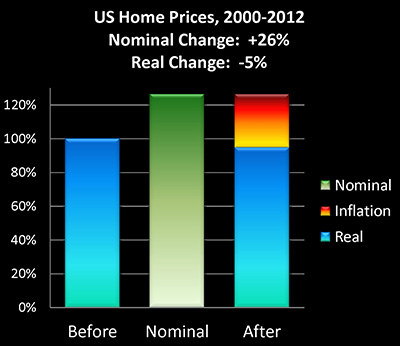
Since the year 2000, a nationally average 5% destruction in the real value of our homes has been masked by a 25% destruction of the value of our money.
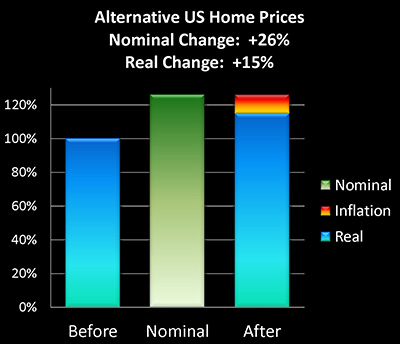
And if we take the usual approach of assuming it must be either inflation or deflation, then we can't tell the difference between a real 5% loss (real asset deflation, that is) or 26% nominal asset inflation, or 15% real asset inflation as shown above, or real 30% asset deflation as shown below:
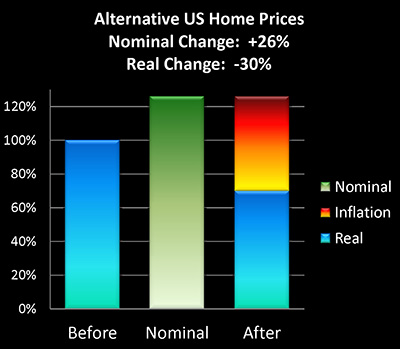
By restricting our choices to either inflation or deflation, but not allowing it to be both – we lose the ability to see reality all together.
So in the real world then, we've experienced simultaneous asset deflation and monetary inflation in the two largest asset markets in the United States – the two largest components of net worth for most households – for the last 12 years.
Is this an anomaly?
To answer that, we must go back in time to another period when the US economy was deeply troubled and struggling with issues of both high unemployment and slow growth – that being the early 1970s to the early 1980s.
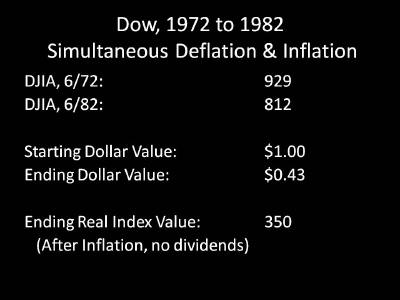
The Dow Jones Industrial Average stood at 929 in June of 1972 – and was 812 by June of 1982, ten years later. Now as you may recall, this ten year period also had the greatest bout of inflation that the US experienced in the 20th Century. The dollar fell in value by 57% in the space of ten years. When we take our ending DJIA number of 812, and adjust for a dollar only being worth 43 cents – the real value of the index was only 350. In purchasing power terms, what our investments will buy for us – the Dow had fallen by almost two thirds.
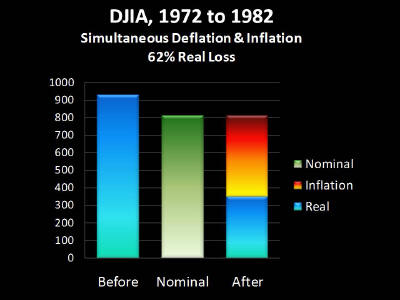
Let me rephrase: the single largest bout of asset deflation in the US since the Great Depression occurred SIMULTANEOUSLY with the single largest destruction of the value of the US dollar in modern history. Asset values fell 62% in real terms, even as money was simultaneously losing 57% of its value.
However, if you are relying on the Econ 101 definition of inflation – you will be blind to this. All you will see is a case of quite mild asset deflation. Which means you will be completely confused. In thinking (as even most commentators do,) that it is EITHER inflation OR deflation, you might quite mistakenly believe that falling asset prices provide at least temporary protection for your money. And this all-too-common theoretical mistake could be deadly for the real world value of many millions of people's savings, as well as their real world standard of living over the coming decades.
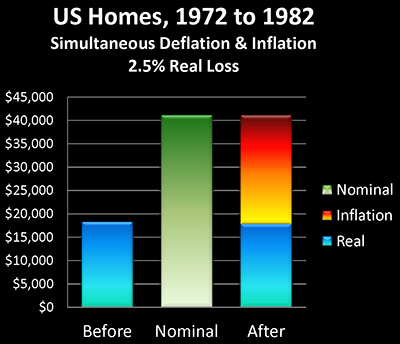
Now how about housing during those same difficult years? In June 1972, the average US home was worth a little over $18,000, and by June 1982 this had increased to a little over $41,000. So the average US home more than doubled in value in a 10 year period, and if you talk to many people who were homeowners during this time, they would tell you their homes were one of the best investments they had ever made.
Until, of course – and this may be sounding a little repetitive, but let me suggest that there is extraordinary value in being able to see that repetition – we adjust for inflation and the 57% destruction of the purchasing power of the dollar. And then we find that in inflation-adjusted terms, the average home actually lost 2.5% of its value over those 10 years, and about $23,000 of our national average $41,000 home value in 1982 was never a gain in real value, but instead actually represented inflation and the destruction of the purchasing power of the US dollar.
So let's put this all together. We have two of the largest markets in the United States – two of the largest components of net worth – with those being the collective value of homes in the United States and the collective value of stock portfolios. We're looking at two long term periods when the economy was stressed, during the years from 1972 until 1982, and from 2000 to 2012. In other words, 22 out of the last 40 years.
For stocks, from 1972 to 1982 and from 2000 to 2012 – we had asset deflation and losses in the value of stocks that were mostly or entirely masked by inflation and the destruction of the value of money.
For homes, from 1972 to 1982 and from 2000 to 2012 – we had asset deflation and a decline in the value of the average single family home that was entirely masked by inflation and the destruction of the value of money.
So for more than half of the last four decades, in the largest markets in the United States, we have had simultaneous asset deflation and money inflation. The decline in the value of assets has been largely offset by the decline in the value of money, and an illusion has been created for the nation. An illusion that cannot be pierced with the Econ 101 definition of inflation, and a reality that can neither be visualized nor anticipated properly when we restrict ourselves to that all-too-common perspective of it being either inflation or deflation, but not both simultaneously.
What recent history shows us is that when it comes to times of economic stress, it is indeed the norm for both inflation and deflation to occur simultaneously, because the destruction of the value of our assets in no way shields us from the destruction of the value of our money.
Real World Theory & Jargon Price 3: Missed Solutions
In addition to blindness and confusion, there is a third real world price for misleading theory and jargon, and it is the worst of the bunch. It is indeed very difficult for any of us to come out ahead when the value of assets and the value of money are each falling over time.
However, it becomes even more difficult when we can't see what is happening, because we have been taught that it has to be either inflation or deflation.
That said, it's not impossible to come out ahead. As one example, tens of millions of people who were homeowners in the 1970s did indeed genuinely experience a surge in their inflation-adjusted net worth, a surge that made home ownership the single most profitable financial decision of their lifetimes for many middle class families.
Now, if you asked most of these people, they would say that it was their homes that were the great investment. Except as we just reviewed, it wasn't the homes, at least not by themselves – because the homes lost value in inflation-adjusted terms.
Gaining a practical understanding of how wealth is redistributed between people and segments of society in an environment of simultaneous inflation and deflation is absolutely crucial for the decades ahead, but to explore it properly would take far more space than a single article.
But the starting place is adjusting our vision, in order to see with perfect clarity that the question is not simply one of inflation or deflation, but rather whether both inflation and deflation will be seen simultaneously in the future, as has happened so often in the past during stressed economic circumstances.
The next time you see the past or future being discussed as either inflation or deflation, my hope is that you will stop and think to yourself: "but wait a minute, what if it's both?"
If you find yourself doing that, I think you may find that this perspective will benefit you for years to come.
 What you have just read is an "eye-opener" about one aspect of the often hidden redistributions of wealth that go on all around us, every day.
What you have just read is an "eye-opener" about one aspect of the often hidden redistributions of wealth that go on all around us, every day.
 A personal retirement "eye-opener" linked here shows how the government's actions to reduce interest payments on the national debt can reduce retirement investment wealth accumulation by 95% over thirty years, and how the government is reducing standards of living for those already retired by almost 50%.
A personal retirement "eye-opener" linked here shows how the government's actions to reduce interest payments on the national debt can reduce retirement investment wealth accumulation by 95% over thirty years, and how the government is reducing standards of living for those already retired by almost 50%.
 An "eye-opener" tutorial of a quite different kind is linked here, and it shows how governments use inflation and the tax code to take wealth from unknowing precious metals investors, so that the higher inflation goes, and the higher precious metals prices climb - the more of the investor's net worth ends up with the government.
An "eye-opener" tutorial of a quite different kind is linked here, and it shows how governments use inflation and the tax code to take wealth from unknowing precious metals investors, so that the higher inflation goes, and the higher precious metals prices climb - the more of the investor's net worth ends up with the government.
 Another "eye-opener" tutorial is linked here, and it shows how governments can use the 1-2 combination of their control over both interest rates and inflation to take wealth from unsuspecting private savers in order to pay down massive public debts.
Another "eye-opener" tutorial is linked here, and it shows how governments can use the 1-2 combination of their control over both interest rates and inflation to take wealth from unsuspecting private savers in order to pay down massive public debts.







If you find these "eye-openers" to be interesting and useful, there is an entire free book of them available here, including many that are only in the book. The advantage to the book is that the tutorials can build on each other, so that in combination we can find ways of defending ourselves, and even learn how to position ourselves to benefit from the hidden redistributions of wealth.


